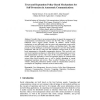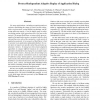109 search results - page 21 / 22 » Using IRP for Malware Detection |
ATC
2009
Springer
13 years 9 months ago
2009
Springer
Currently, there is an increasing tendency to migrate the management of communications and information systems onto the Web. This is making many traditional service support models ...
IEEEARES
2010
IEEE
14 years 20 days ago
2010
IEEE
—Program obfuscation is often employed by malware in order to avoid detection by anti-virus software, but it has many other legitimate uses, such as copy protection, software lic...
ACSAC
2006
IEEE
13 years 12 months ago
2006
IEEE
Performing sensitive online transactions using computers found in cybercaf´es and public libraries is risky. The untrusted nature of these machines creates a target rich environm...
IJDE
2006
13 years 5 months ago
2006
Rootkits are malicious programs that silently subvert an operating system to hide an intruder's activities. Although there are a number of tools designed to detect rootkits, ...
NDSS
2006
IEEE
13 years 11 months ago
2006
IEEE
For many applications—including recognizing malware variants, determining the range of system versions vulnerable to a given attack, testing defense mechanisms, and filtering m...


